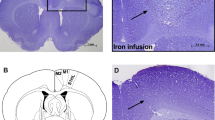Summary
Preliminary observations on human autopsy material have indicated that damaged neurons may take up plasma proteins early after the injury. These observations prompted an experimental study under controlled conditions. Focal brain lesions were produced in rats by extracranial application of dry ice for 90 s. This caused an immediate disruption of the blood-brain barrier with leakage of plasma components into the tissue and sharply circumscribed areas of necrosis of the underlying cortex. Five minutes after the lesion, uptake of albumin, fibrinogen and fibronectin into damaged neurons was demonstrated by immunostains. These proteins were retained in the injured neurons until they were phagocytized 2–4 days later. In addition, normal neurons whose axons or axon collaterals passed through or terminated in the lesion were labeled. This labeling was generally weaker than in damaged neurons and no labeling of neuronal nuclei was observed in these cells in contrast to those of damaged cells. Apart from nerve cells labeled through retrograde axonal transport, no staining of normal neurons was observed. Intravenous injections of Evans blue, which binds to plasma proteins, confirmed that albumin was taken up into damaged neurons almost immediately after the injury and showed that this uptake continued for at least 20 h. It is concluded that uptake of plasma proteins into damaged neurons may serve as early (and late) markers of neuronal injury.
Similar content being viewed by others
References
Bakay L, Haque IUL (1964) Morphological and chemical studies in cerebral edema. J Neuropathol Exp Neurol 23: 393–418
Baker RN, Cancilla PA, Pollock PS (1971) The movement of exogenous protein in experimental cerebral edema. J Neuropathol Exp Neurol 30: 668–679
Blakemore WF (1969) The fate of escaped plasma protein after thermal necrosis of the rat brain: an electron microscope study. J Neuropathol Exp Neurol 28: 139–152
Bothe HW, Bodsch W, Hossmann K-A (1984) Relationship between specific gravity, water content and serum protein extravasation in various types of vasogenic brain edema. Acta Neuropathol (Berl) 64: 37–42
Brightman MW, Klatzo I, Olsson Y, Reese TS (1970) The blood-brain barrier to proteins under normal and pathological conditions. J Neurol Sci 10: 215–239
Broadwell RD, Brightman MW (1976) Entry of peroxidase into neurons of the central and peripheral nervous systems from extracerebral and cerebral blood. J Comp Neurol 166: 257–284
Fabian RH, Petroff G (1987) Intraneuronal IgG in the central nervous system: uptake by retrograde axonal transport. Neurology 37: 1780–1784
Fredriksson K, Kalimo H, Nordborg C, Johansson BB, Olsson Y (1988) Nerve cell injury in the brain of stroke-prone spontaneously hypertensive rats. Acta Neuropathol 76: 227–237
Fredriksson K, Kalimo H, Nordborg C, Olsson Y, Johansson BB (1988) Cyst formation and glial response in the brain lesions of stroke-prone spontaneously hypertensive rats. Acta Neuropathol 76: 441–450
Ito U, Go KG, Walker JT, Spatz M, Klatzo I (1976) Experimental cerebral ischemia in mongolian gerbils. III. Behaviour of the blood-brain barrier. Acta Neuropathol (Berl) 34: 1–6
Klatzo I (1967) Neuropathological aspects of brain edema. J Neuropathol Exp Neurol 26: 1–14
Klatzo I, Miquel J (1960) Observations on pinocytosis in nervous tissue. J Neuropathol Exp Neurol 19: 475–487
Klatzo I, Piraux A, Laskowski EJ (1958) The relationship between edema, blood-brain barrier and tissue elements in a local brain injury. J Neuropathol Exp Neurol 17: 548–654
Klatzo I, Miquel J, Otenasek R (1962) The application of fluorescein labeled serum proteins (FLSP) to the study of vascular permeability in the brain. Acta Neuropathol (Berl) 2: 144–160
Kirstensson K, Olsson Y (1971) Retrograde axonal transport of protein. Brain Res 29: 363–365
Kuroiwa T, Cahn R, Juhler M, Goping G, Campbell G, Klatzo I (1985) Role of extracellular proteins in the dynamics of vasogenic brain edema. Acta Neuropathol (Berl) 66: 3–11
Liu HM (1988) Neovasculature and blood-brain barrier in ischemic brain infaret. Acta Neuropathol (Berl) 75: 422–426
Liu HM, Sturner WQ (1988) Extravasation of plasma proteins in brain trauma. Forensic Sci Int 38: 285–295
Mossakowski MJ, Long DM, Myers RE, de Curet HR, Klatzo I (1968) Early histochemical changes in perinatal asphyxia. J Neuropathol Exp Neurol 27: 500–515
Møllgard K, Jacobsen M, Krag Jacobsen G, Praetorius Clausen P, Saunders NR (1979) Immunohistochemical evidence for an intracellular localization of plasma proteins in human foetal choroid plexus and brain. Neurosci Lett 14: 85–90
Reese TS, Karnovsky MJ (1967) Fine structural localization of a blood-brain barrier to exogenous peroxidase. J Cell Biol 34: 207–217
Reulen HJ, Graham R, Spatz M, Klatzo I (1977) Role of pressure gradients and bulk flow in dynamics of vasogenic brain edema. J Neurosurg 46: 24–35
Rinder L, Olsson Y (1968) Vascular permeability changes in experimental brain concussion. Acta Pathol Microbiol Scand 72: 350–352
Salahuddin TS, Kalimo H, Johansson BB, Olsson Y (1988) Observations on exudation of fibronectin, fibrinogen and albumin in the brain after carotid infusion of hyperosmolar solutions. Acta neuropathol (Berl) 76: 1–10
Sokrab T-EO, Johansson BB, Kalimo H, Olsson Y (1988) A transient hypertensive opening of the blood-brain barrier can lead to brain damage. Acta Neuropathol (Berl) 75: 557–565
Sparrow JR (1981) Immunocytochemical localization of plasma proteins in neuronal perikarya: Brain Res 212: 159–163
Tengvar C (1986) Extensive intraneuronal spread of horseradish peroxidase from a focus of vasogenic edema into remote areas of central nervous system. Acta Neuropathol (Berl) 71: 177–189
Tengvar C, Olsson Y (1982) Uptake of macromolecules into neurons from a focal vasogenic cerebral edema and subsequent axonal spread to other brain regions. Acta Neuropathol (Berl) 57: 233–235
Westergaard E, Go G, Klatzo I, Spatz M (1976) Increased permeability of cerebial vessels to horseradish peroxidase induced by ischemia in mongolian gerbils. Acta Neuropathol (Berl) 35: 307–325
Wolman M, Klatzo I, Chui E, Wilmes F, Nishimoto K, Fujiwara K, Spatz M (1981) Evaluation of the dye-protein tracers in pathophysiology of the blood-brain barrier. Acta Neuropathol (Berl) 54: 55–61
Author information
Authors and Affiliations
Rights and permissions
About this article
Cite this article
Løberg, E.M., Torvik, A. Uptake of plasma proteins into damaged neurons. Acta Neuropathol 81, 479–485 (1991). https://doi.org/10.1007/BF00310126
Received:
Revised:
Accepted:
Issue Date:
DOI: https://doi.org/10.1007/BF00310126




